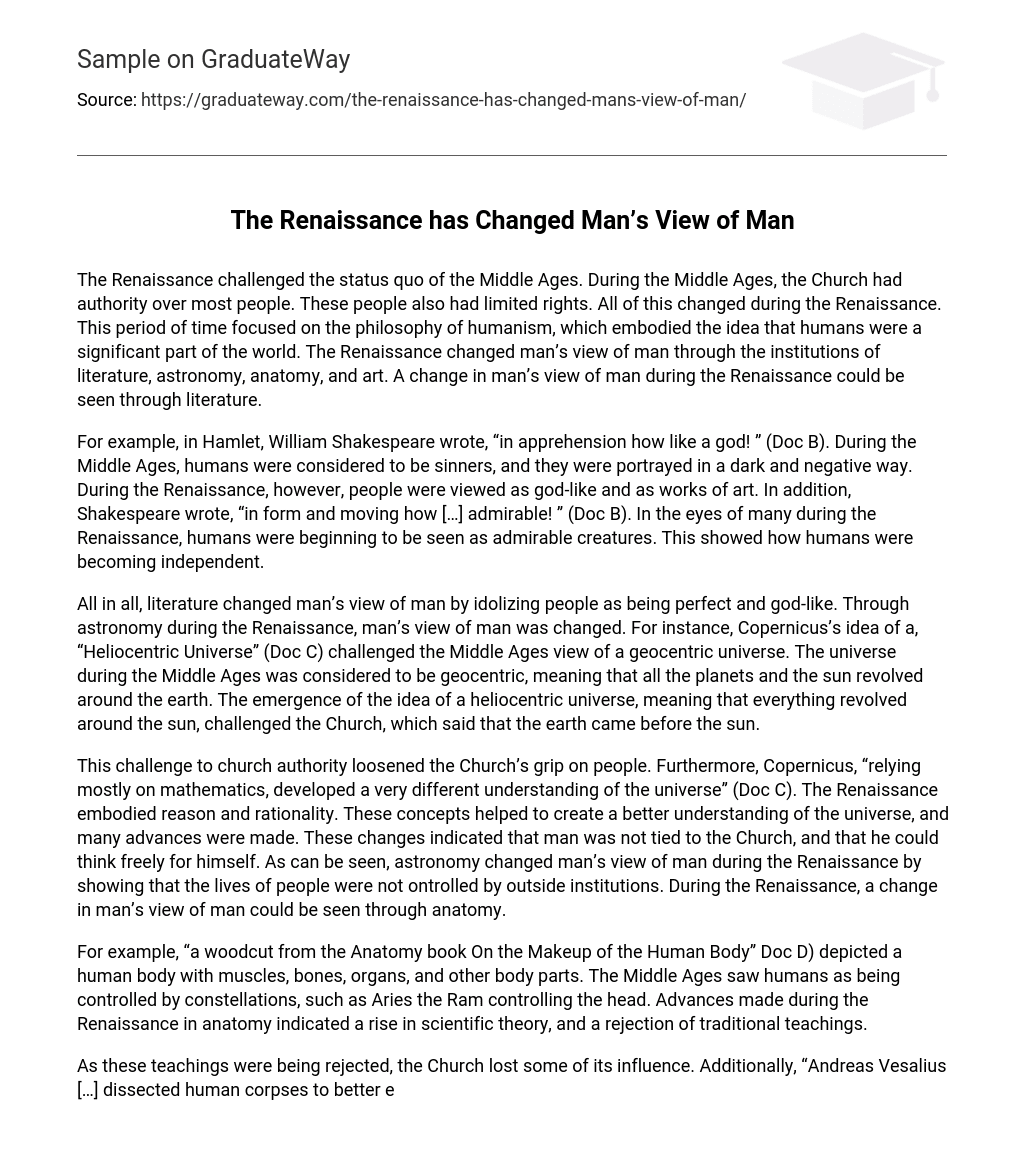The Renaissance challenged the status quo of the Middle Ages. During the Middle Ages, the Church had authority over most people. These people also had limited rights. All of this changed during the Renaissance. This period of time focused on the philosophy of humanism, which embodied the idea that humans were a significant part of the world. The Renaissance changed man’s view of man through the institutions of literature, astronomy, anatomy, and art. A change in man’s view of man during the Renaissance could be seen through literature.
For example, in Hamlet, William Shakespeare wrote, “in apprehension how like a god! ” (Doc B). During the Middle Ages, humans were considered to be sinners, and they were portrayed in a dark and negative way. During the Renaissance, however, people were viewed as god-like and as works of art. In addition, Shakespeare wrote, “in form and moving how […] admirable! ” (Doc B). In the eyes of many during the Renaissance, humans were beginning to be seen as admirable creatures. This showed how humans were becoming independent.
All in all, literature changed man’s view of man by idolizing people as being perfect and god-like. Through astronomy during the Renaissance, man’s view of man was changed. For instance, Copernicus’s idea of a, “Heliocentric Universe” (Doc C) challenged the Middle Ages view of a geocentric universe. The universe during the Middle Ages was considered to be geocentric, meaning that all the planets and the sun revolved around the earth. The emergence of the idea of a heliocentric universe, meaning that everything revolved around the sun, challenged the Church, which said that the earth came before the sun.
This challenge to church authority loosened the Church’s grip on people. Furthermore, Copernicus, “relying mostly on mathematics, developed a very different understanding of the universe” (Doc C). The Renaissance embodied reason and rationality. These concepts helped to create a better understanding of the universe, and many advances were made. These changes indicated that man was not tied to the Church, and that he could think freely for himself. As can be seen, astronomy changed man’s view of man during the Renaissance by showing that the lives of people were not ontrolled by outside institutions. During the Renaissance, a change in man’s view of man could be seen through anatomy.
For example, “a woodcut from the Anatomy book On the Makeup of the Human Body” Doc D) depicted a human body with muscles, bones, organs, and other body parts. The Middle Ages saw humans as being controlled by constellations, such as Aries the Ram controlling the head. Advances made during the Renaissance in anatomy indicated a rise in scientific theory, and a rejection of traditional teachings.
As these teachings were being rejected, the Church lost some of its influence. Additionally, “Andreas Vesalius […] dissected human corpses to better explain the human body […]” (Doc D). Vesalius had taken matters into his own hands, and he created a detailed engraving of the human body that challenged Church authority. His findings showed that people had control over themselves and their health, and that they could live their lives how they wanted to. All in all, man’s view of man was changed during the Renaissance, through anatomy, by showing that people had control of their lives.
A change in man’s view of man during the Renaissance could be seen through art. For example, in Renaissance art, “One begins to […] feel stronger emotions in the subjects” (Doc A). The Middle Ages were a time in which the sole purpose of art was to represent religion. During the Renaissance, the artists were more involved, and stronger pride was taken in the actual subjects of the paintings. This coincided with Humanism, which stressed the value and importance of humans. Furthermore, “the new artistic styles would echo the broader movements and interests of the new age” (Doc A).
The purpose of art was no longer just to please the Church, but it was to inspire those that viewed it. Renaissance art was portrayed in a natural, realistic way, which showed that humans were more self reliant. As can be seen, art during the Renaissance changed man’s view of man by depicting humans as being more independent. Through the institutions of art, astronomy, anatomy, and literature, man’s view of man was changed during the Renaissance. A change in man’s view of man could be seen in literature, as in how humans were now idealized.
Changes could also be seen through astronomy, as it showed that people were less constrained by the Church. Furthermore, a change is man’s view of man came forth through anatomy, which exposed that idea that people had control over their lives. Finally, a change in man’s view of man could be seen through art, as in how people became more independent. The Renaissance way of thinking has played a significant role in our education system today. All the way from Kindergarten through high school, students are educated on a variety of subjects, not just on one.





